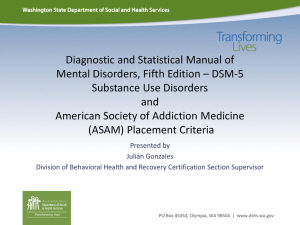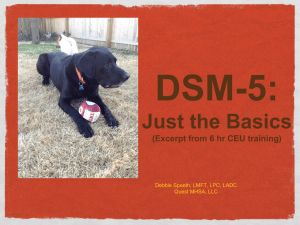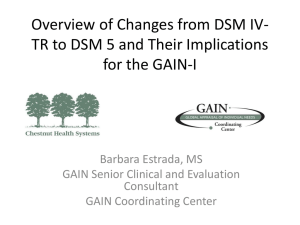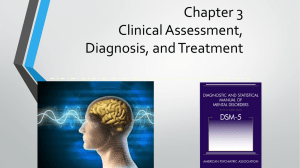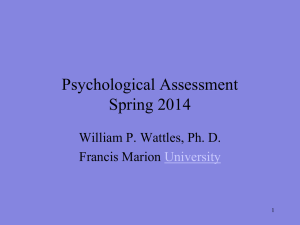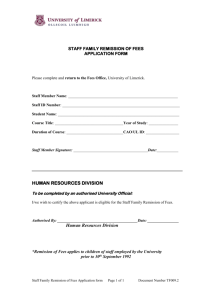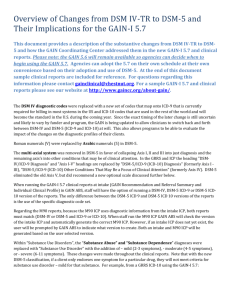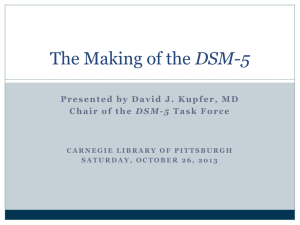The DSM IV diagnostic codes were replaced with a new set
advertisement
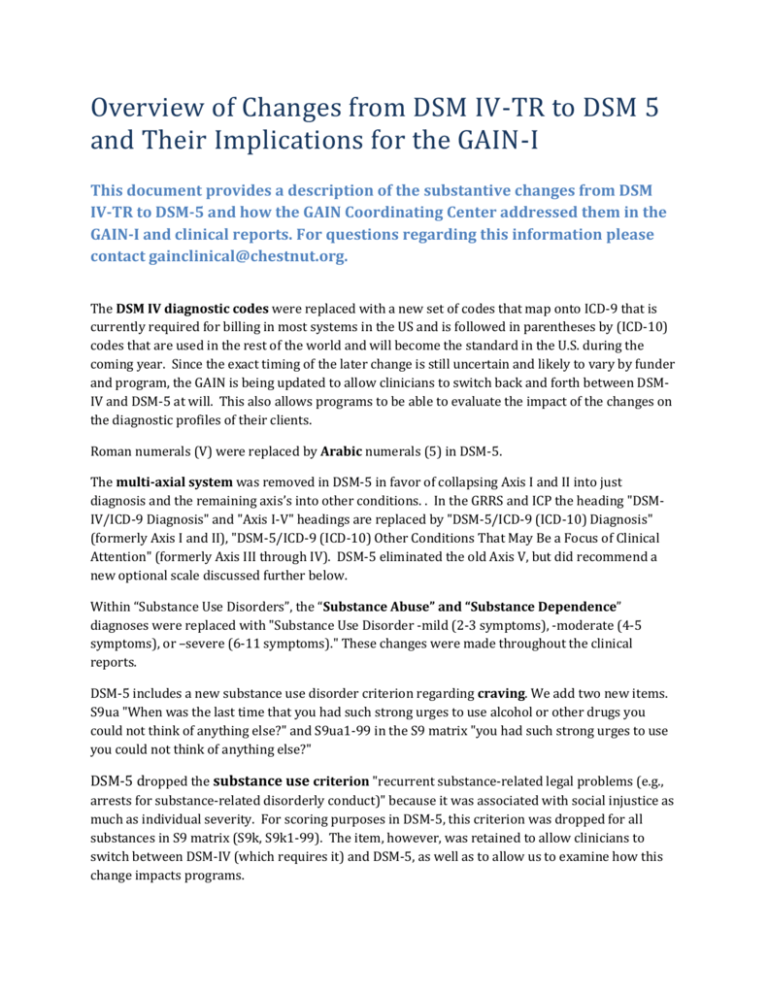
Overview of Changes from DSM IV-TR to DSM 5 and Their Implications for the GAIN-I This document provides a description of the substantive changes from DSM IV-TR to DSM-5 and how the GAIN Coordinating Center addressed them in the GAIN-I and clinical reports. For questions regarding this information please contact gainclinical@chestnut.org. The DSM IV diagnostic codes were replaced with a new set of codes that map onto ICD-9 that is currently required for billing in most systems in the US and is followed in parentheses by (ICD-10) codes that are used in the rest of the world and will become the standard in the U.S. during the coming year. Since the exact timing of the later change is still uncertain and likely to vary by funder and program, the GAIN is being updated to allow clinicians to switch back and forth between DSMIV and DSM-5 at will. This also allows programs to be able to evaluate the impact of the changes on the diagnostic profiles of their clients. Roman numerals (V) were replaced by Arabic numerals (5) in DSM-5. The multi-axial system was removed in DSM-5 in favor of collapsing Axis I and II into just diagnosis and the remaining axis’s into other conditions. . In the GRRS and ICP the heading "DSMIV/ICD-9 Diagnosis" and "Axis I-V" headings are replaced by "DSM-5/ICD-9 (ICD-10) Diagnosis" (formerly Axis I and II), "DSM-5/ICD-9 (ICD-10) Other Conditions That May Be a Focus of Clinical Attention" (formerly Axis III through IV). DSM-5 eliminated the old Axis V, but did recommend a new optional scale discussed further below. Within “Substance Use Disorders”, the “Substance Abuse” and “Substance Dependence” diagnoses were replaced with "Substance Use Disorder -mild (2-3 symptoms), -moderate (4-5 symptoms), or –severe (6-11 symptoms)." These changes were made throughout the clinical reports. DSM-5 includes a new substance use disorder criterion regarding craving. We add two new items. S9ua "When was the last time that you had such strong urges to use alcohol or other drugs you could not think of anything else?" and S9ua1-99 in the S9 matrix "you had such strong urges to use you could not think of anything else?" DSM-5 dropped the substance use criterion "recurrent substance-related legal problems (e.g., arrests for substance-related disorderly conduct)" because it was associated with social injustice as much as individual severity. For scoring purposes in DSM-5, this criterion was dropped for all substances in S9 matrix (S9k, S9k1-99). The item, however, was retained to allow clinicians to switch between DSM-IV (which requires it) and DSM-5, as well as to allow us to examine how this change impacts programs. DSM-5 added cannabis withdrawal symptoms as endorsing 3 or more of 1) Irritability, anger, or aggression, 2) Nervousness or anxiety, 3) Sleep difficulty, 4) Decreased appetite or weight loss, 5) Restlessness, 6) Depressed mood , and 7) Physical discomfort. We added two new withdrawal symptoms to for cannabis withdrawal: Irritability, anger, or aggression (new item S3c20), and depressed mood (S3c21). The other symptoms were already in the GAIN. DSM-5 replaced “Tobacco dependence” with tobacco use disorder (mild, moderate, severe). These new questions match the criteria for other drugs currently in the GAIN and the exact wording of the new craving item. We add four items for tobacco use. R1ch: repeatedly caused you not to meet your responsibilities, R1cj: you repeatedly used in unsafe situations, R1cm: did you keep using even though it was leading to fights or getting you into trouble with other people, R1ua: When was the last time that you had such strong urges to take the drug that you could not think of anything else. Changes to specifiers were made throughout the clinical reports to account for DSM-5 changes: Removal of specifiers "with physiological symptoms” and "without physiological symptoms." The remission specifiers were deleted. Remission specifiers "Sustained Partial Remission" and "Sustained Full Remission" replaced with "In Sustained Remission". The remission specifiers were changed. Remission specifiers "Early Partial Remission" and "Early Full Remission" replaced with "In Early Remission,” the timeframe for early remission was changed to from 1 month to 3 months and added the exception for craving. The remission specifiers were changed. To allow for either the DSM-IV or 5 timeframes for early remission, we changed the S9 response set to Past Month, 2 to 3 Months Ago, 4 to 12 Months Ago, 1-3 Years Ago, More than 3 Years Ago, and Never. Substance/Class Changes were made throughout the clinical reports to account for new DSM-5 classification: Amphetamine and Cocaine were collapsed into Stimulant Use Disorder PCP was collapsed into Hallucinogen Use Disorder. All substance use disorders allow specification of primary form of a drug used within a class (e.g., Amphetamine, Methamphetamine, Cocaine, Crack, PCP, Oxycontin) According to DSM-5 Major Depressive Disorder includes a new symptom, "Feelings of worthlessness or excessive or inappropriate guilt (which may be delusional) nearly every day (not merely self-reproach or guilt about being sick).” We added a new item (M1b13) "Feeling worthless or that the bad things that have happened in your life are your fault.” The item was simplified from the DSM-5 symptom for ease of administration. DSM-5 has renamed "Pathological Gambling" to "Gambling Disorder". The criterion “paid for your gambling with bad checks, someone else's money, or with something that didn't belong to you” no longer included in diagnostic criteria for DSM-5 and we changed the terminology throughout the reports. Item V9h was kept to allow clinicians to switch between DSM-IV and DSM-5 and to evaluate the impact of the change. DSM-5 included several changes to ADHD which we have made: "Attention Deficit Hyperactive Disorder - Combined Type" changed to "AttentionDeficit/Hyperactivity Disorder - Combined presentation". Criterion changed to up to age 16 requires 6 or more inattention symptoms and 6 or more hyperactivity/ impulsivity symptoms; age 17 and older requires 5 or more inattention symptoms and 5 or more hyperactivity/impulsivity symptoms. “Attention Deficit Hyperactive Disorder - Inattentive Type" changed to "AttentionDeficit/Hyperactivity Disorder - Predominantly inattentive presentation". Criterion changed to up to age 16 requires 6 or more inattention symptoms; age 17 and older requires 5 or more inattention symptoms. "Attention Deficit Hyperactive Disorder - Hyperactive Type" changed to "AttentionDeficit/Hyperactivity Disorder - Predominantly Hyperactive/Impulsive Presentation”. Criterion changed to up to age 16 requires 6 or more hyperactivity/impulsivity symptoms; age 17 and older requires 5 or more hyperactivity/impulsivity symptoms. ADHD age of on-set criteria raised form age 7 to 15. The higher ages of onset is still allowed as provisional. DSM-5 Replaced "Not Otherwise Specified" to "Unspecified”, and "Rule Out" to "Provisional". These changes were made throughout the clinical reports. DSM-5 recommends the use of V Codes from ICD-9-CM or Z codes from ICD-10-CM for previous sections for Axis III and IV. We have included appropriate V codes and Z codes to describe client self-report where possible. However, the previous list of psychosocial problems will also print in the clinical reports. DSM-5 dropped Axis V GAF . DSM-5 recommends use of WHODAS 7 General Disability Score in order to provide a global measure of disability. We have added 8 items (XDSM5g-q) at the end of the GAIN and in the GRRS and ICP section “Other Conditions that May be a Focus of Clinical Attention.” The items correspond to the 7 subscale and total score for the WHODAS 7 General Disability Scores (Understanding and communicating, Getting around, Self-care, Setting along with people, Life activities-Household, Life activities-school/work, Participating in society, and Total).
